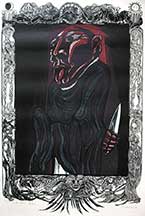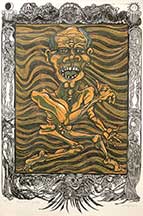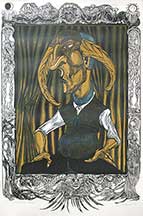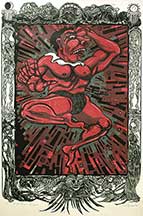



The Four Humors, Series of linocut prints, each 34” x 22 1/2”, 2004, edition of 15

Choleric - Black Bile, Black Humor, Commedia dell Arte - Il Dottore, Chico Marx, Occupation - Priest
Jaundice - Yellow Bile, Sarcastic Humor, Commedia dell Arte - Pulcinella, Groucho Marx (in Duck Soup) occupation - Politician
Phlegmatic - Phlegm, Dry Humor, Commedia dell Arte - Pantalone, Groucho Marx (in Horse Feathers) , occupation - Academic
Sanguine - Blood, Slapstick humor, Commedia dell Arte - Arlecchino (Harlequin), Harpo Marx, occupation - Actor.
The Four Humors
The Medieval concept of health and psychology rested partially
on the interaction of the four humors or bodily fluids. These are
traditionally black bile, yellow
bile, phlegm and blood. Personality types, and various disease were attributed
to a lack or an over abundance of a particular humor.
This series of the four humors was partially inspired by Russian literary critic
Mikhail Bakhtin’s idea of grotesque realism. Bahktin described it as
disrespectful to authority, non-canonical, mocking and transcendent.
Grotesque realism is the great dancing nihilism of the exaggerated, the overblown,
the hyperbolic sense that treats of all basic human realities directly and
with candor and a light touch. The dancing cynic punctures the shibboleths
of a bloated, benumbed and befuddled world, smashes the puffed up spectacle
of the politician riding high on power and pushing their addictive drugs of
fear on a cowed and infinitely distractible public.
It is the physicians craft to diagnose. The grotesque realists source of diagnosis
is cynicism his suggested treatment is satire. Laughter, true laughter fears
nothing, opens the door to the golden age where all wines flowed. True laughter
erupts bubbling from the scum of the earth, from the cynic, the clown, the
fool, the artist, the scum of society, despised as worthless, not even worth
their weight in stock options. This scum is the only regenerative force for
an aged decrepit society.
In the process of working on these prints several associations came to mind.
One was with the Commedia dell Arte characters. The Commedia was a series of
stock characters playing unscripted scenarios to public market audiences from
at least the Renaissance on to the early twentieth century. The characters
of Harlequin and Pierrot are familiar to us from French painting. I also associated
the four humors with the Marx Brothers. These ideas are neither essential nor
necessarily important but I found that thinking of the humors in different
lights suggested an alternate world view to that of the historical authorized
version. That is the bawdy world of the public square where life is theater
and humor through its grotesqueries is the only true power.



